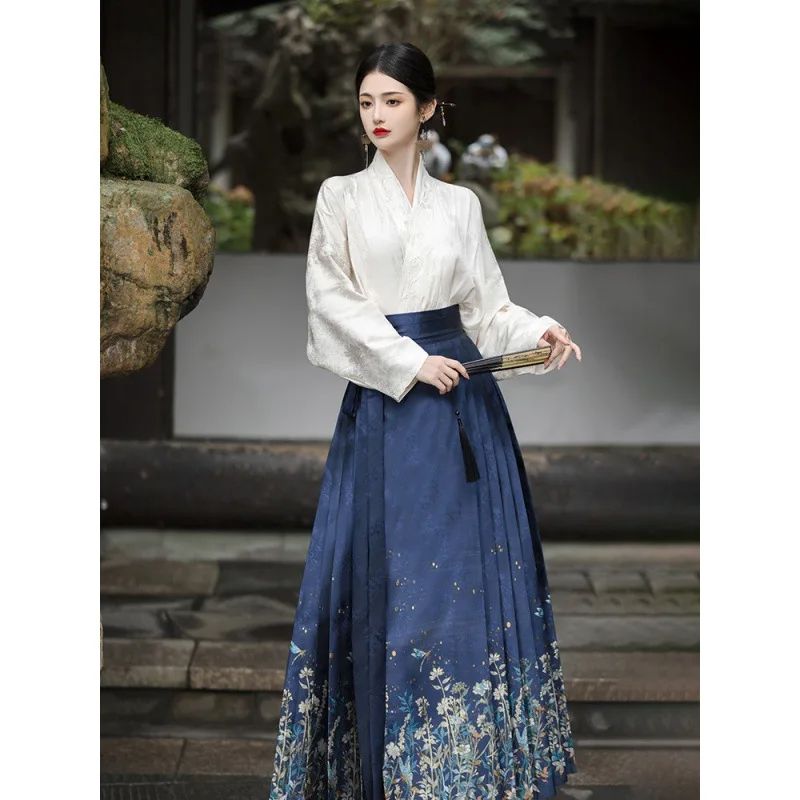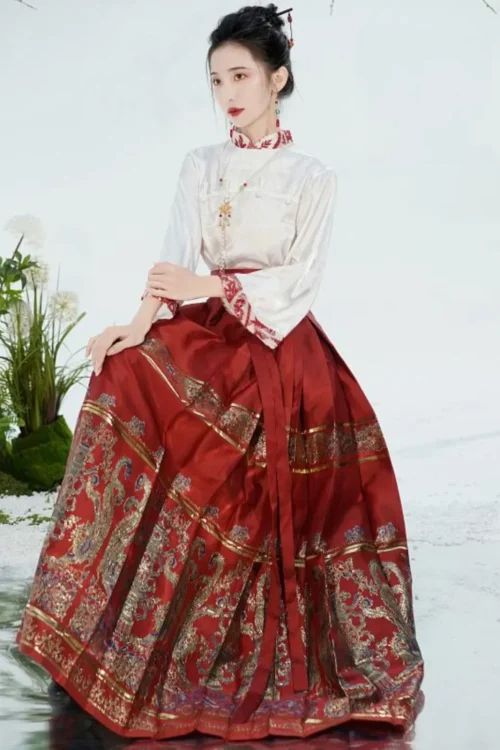The History and Evolution of the Mamianqun
The mǎmiànqún, a traditional Chinese Kleidungsstück, has captivated fashion enthusiasts for centuries. Its timeless elegance and intricate craftsmanship have recently garnered renewed attention, as it finds a place in the world of modern luxury.

Origins and Early History
The mǎmiànqún, literally meaning “horse-face skirt,” originated during the Ming-Dynastie (1368-1644). It is characterized by its high waist, pleated front, and flowing skirt. The garment was initially worn by women of the upper classes, who appreciated its flattering silhouette and the intricate embroidery that often adorned it.
Evolution Through the Dynasties
Over time, the mǎmiànqún evolved to reflect changing societal norms. During the Qing dynasty (1644-1912), it became more elaborate, with wider pleats and more intricate embroidery. The garment gained popularity among women of all social classes, becoming a staple of traditional Chinese attire.
20th Century Changes
In the 20th century, the mǎmiànqún faced a decline in popularity as Western fashion influences became more prevalent. However, in recent years, there has been a resurgence of interest in traditional Chinese culture, leading to a renewed appreciation for the mǎmiànqún.
Contemporary Designers and Revival
This revival has been fueled by the efforts of contemporary designers who have reinterpreted the garment for the modern era. One such designer is Hermès, the renowned French luxury brand. Hermès has incorporated elements of the mǎmiànqún into its collections, creating pieces that blend traditional Chinese aesthetics with modern Parisian chic.
Hermès’ Design Elements
Hermès’ mǎmiànqún designs feature the garment’s signature high waist and pleated front, but they are updated with contemporary fabrics and embellishments. The brand’s use of luxurious materials, such as silk and cashmere, elevates the mǎmiànqún to a new level of sophistication.
Fazit
The collaboration between Hermès and the mǎmiànqún is a testament to the enduring appeal of this timeless garment. By combining traditional Chinese craftsmanship with modern luxury, Hermès has created pieces that celebrate the rich heritage of the mǎmiànqún while making it relevant to the contemporary fashion landscape.
Hermès’ Modern Interpretation of the Mǎmiànqún
In the realm of fashion, where tradition and innovation intertwine, Hermès has embarked on a captivating journey by reimagining the timeless mǎmiànqún for the modern era. This exquisite piece, steeped in centuries of cultural heritage, has found a new expression in the hands of Hermès’ skilled artisans.

The Mǎmiànqún’s Distinctive Features
The mǎmiànqún originated during the Ming dynasty and was worn by Frauen of all social classes. Its distinctive features include a high waist, a full, pleated skirt, and an apron-like panel that covers the front. Hermès has meticulously preserved these elements while infusing the garment with its signature elegance and contemporary flair.
Luxurious Craftsmanship
Crafted from the finest silk, Hermès’ mǎmiànqún exudes a luxurious sheen and a delicate drape. The vibrant colors and intricate patterns, inspired by traditional Chinese motifs, evoke a sense of timeless beauty. The high waistline accentuates the wearer’s figure, while the full skirt creates a graceful silhouette that flows effortlessly with movement.
Modern Adaptations
The apron panel, a defining characteristic of the mǎmiànqún, has been reinterpreted by Hermès with a touch of modernity. Adorned with intricate embroidery or subtle embellishments, it adds a touch of opulence to the garment. The panel also serves a practical purpose, providing additional coverage and warmth.
Cultural Heritage and Contemporary Design
Hermès’ mǎmiànqún is not merely a fashion statement but a testament to the enduring power of cultural heritage. By blending traditional craftsmanship with contemporary design, Hermès has created a garment that transcends time and appeals to a discerning clientele. It is a piece that can be worn for both formal and casual occasions, embodying the timeless elegance of the mǎmiànqún while embracing the modern spirit of Hermès.
Fazit
In conclusion, Hermès’ modern interpretation of the mǎmiànqún is a masterpiece that seamlessly fuses tradition and innovation. It is a testament to the enduring appeal of cultural heritage and the transformative power of contemporary design. As a symbol of timeless elegance and modern luxury, Hermès’ mǎmiànqún is destined to become a cherished piece in the wardrobes of fashion-forward individuals worldwide.
The Cultural Significance of the Mǎmiànqún in Contemporary Fashion
In the realm of fashion, where tradition and modernity intertwine, the mǎmiànqún, an ancient Chinese garment, has emerged as a symbol of cultural resurgence and contemporary luxury. Its timeless elegance has captivated the attention of renowned fashion houses, including Hermès, who have embraced its rich heritage and reimagined it for the modern era.

Historical Importance
The mǎmiànqún, literally meaning “horse-face skirt,” originated during the Tang Dynasty (618-907 CE). It was a garment worn by women of all social classes, from commoners to empresses. Its distinctive features include a high waist, a long, flowing skirt, and a unique pleated front panel that resembles a horse’s face.
Moderne Neuinterpretationen
In contemporary fashion, the mǎmiànqún has been reinterpreted by designers who appreciate its historical significance and aesthetic appeal. Hermès, known for its exquisite craftsmanship and timeless designs, has incorporated elements of the mǎmiànqún into its collections. The house’s iconic scarves, for example, have been adorned with intricate mǎmiànqún motifs, paying homage to the garment’s rich cultural heritage.
Symbol of National Pride
Beyond Hermès, other fashion designers have also drawn inspiration from the mǎmiànqún. Chinese designers, in particular, have embraced the garment as a symbol of national pride and cultural identity. They have reimagined the mǎmiànqún in a variety of contemporary styles, from avant-garde to streetwear, showcasing its versatility and adaptability.
Kulturelle Wertschätzung
The resurgence of the mǎmiànqún in modern fashion reflects a growing appreciation for cultural diversity and the preservation of traditional crafts. It is a testament to the enduring power of fashion to transcend time and boundaries, connecting the past with the present and inspiring creativity in the future.
Fazit
As the mǎmiànqún continues to captivate the fashion world, it serves as a reminder of the rich cultural heritage that informs contemporary design. Its timeless elegance and adaptability have made it a symbol of both tradition and innovation, bridging the gap between ancient China and the modern world.
